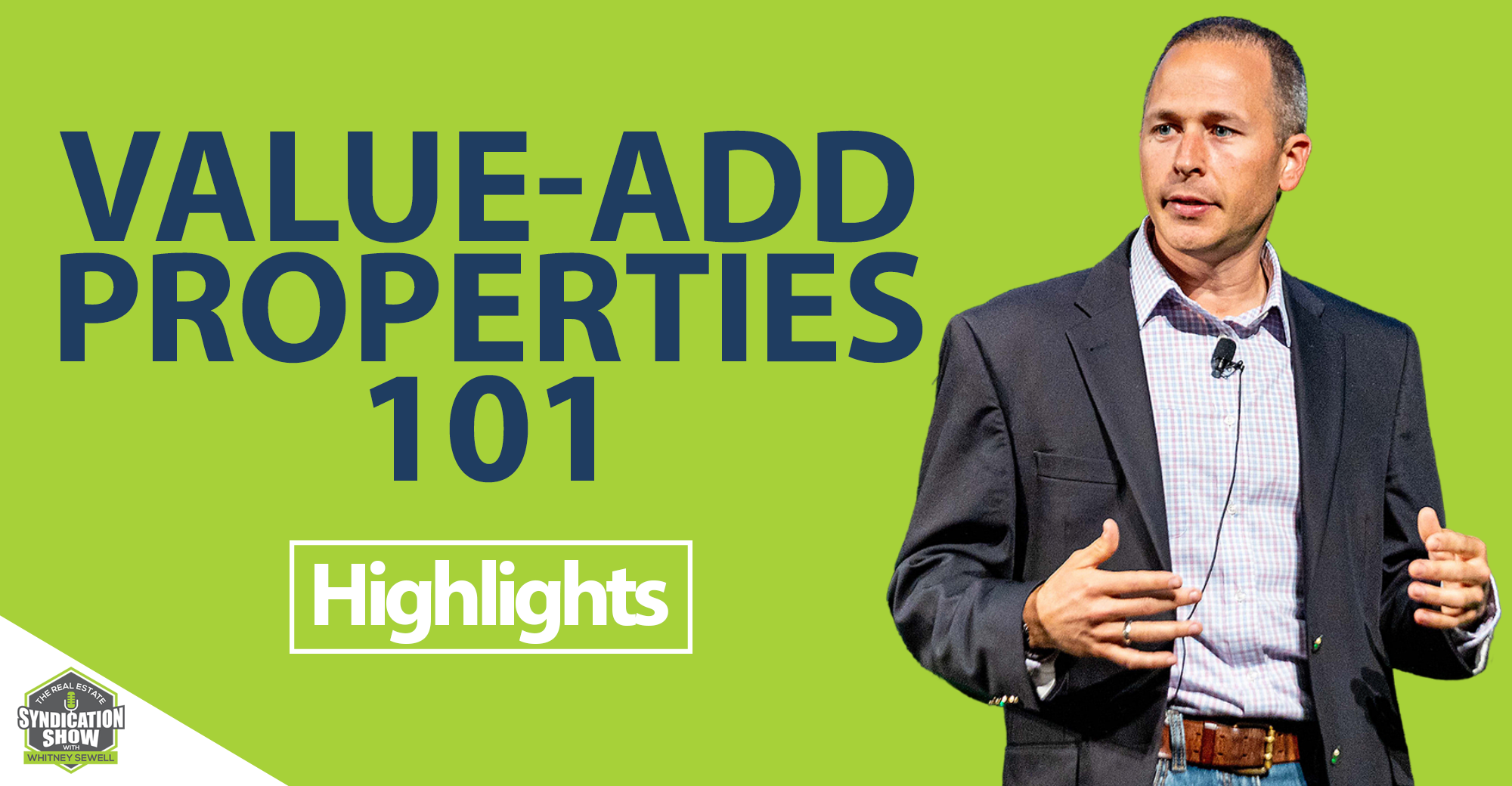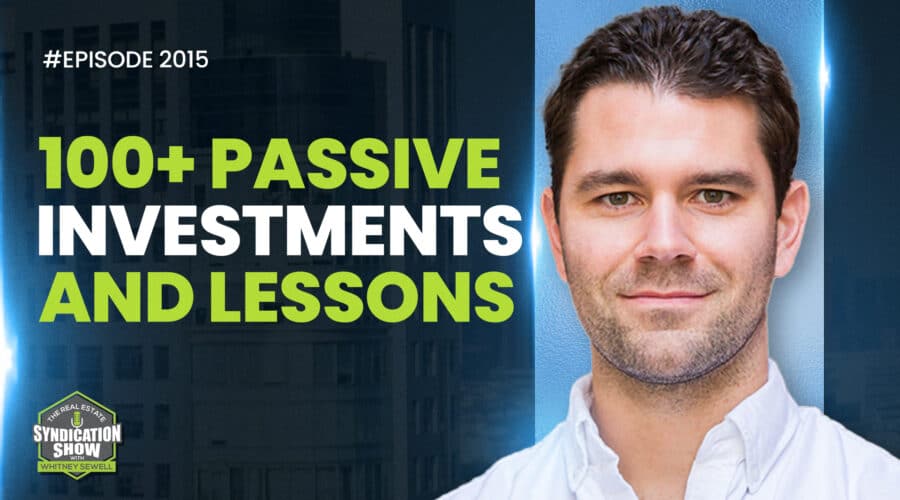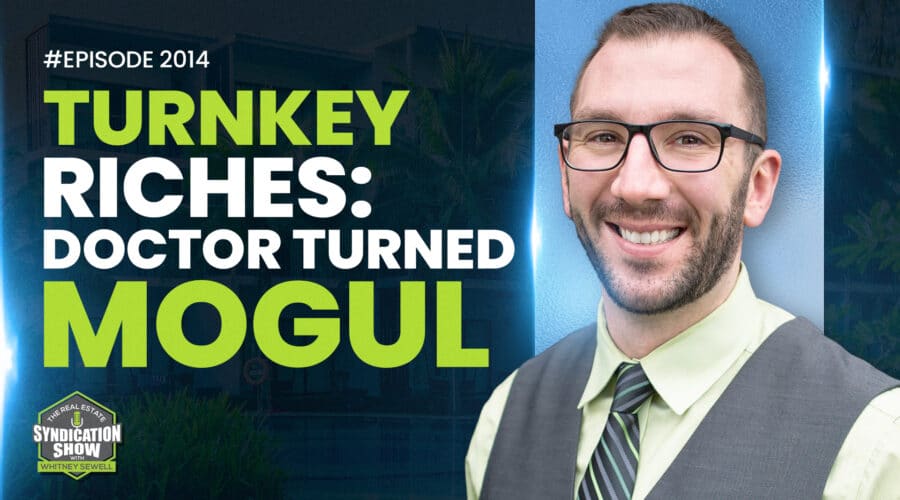There is, indeed, a value to value-add properties. In today’s #Highlights episode, we feature our conversations again with real estate entrepreneurs Jeff Schechter and Sakar Kawle. The two detail what value-add properties really are and how this can be an advantage for you.
Watch the episode here:
Listen to the podcast here:
Jeff talks about how his curiosity for internet marketing and real estate led him to his current business which is rehabbing properties. Meanwhile, Sakar walks us through his entry into real estate, talks about his successes, gives his thoughts on the current climate of real estate, and shares valuable tips on multifamily, syndication, and value-add properties. Enjoy the show!
Key Points From This Episode:
- Jeff shares his journey in the real estate industry.
- The key to Jeff’s success has been in systems and he elaborates how this helped him grow his business.
- How did Jeff learn from making mistakes in the beginning?
- The two things that equate to success in a real estate investment.
- The story of how Sakar transitioned into the world of real estate.
- Hear about how he methodically and radically scaled up his personal portfolio.
- Sakar talks about the difference between value-add properties to capital improvements.
- Sakar talks about the things he is focused on right now.
- How Saker is weathering the storm?
Tweet This!
“Once we know exactly what our costs were and all that stuff, we can make a fair profit. We can get to some fair numbers for the investor. It puts us on the hook to make sure that the end price is something that’s attractive to the end investor from an ROI standpoint. It puts the responsibility on us.” – Jeff Schechter
“There are only two things that equate to success in a real estate investment. One is you’ve got to have a property that’s in good condition. Secondly, you have to have a happy tenant because if either one of those is out of whack, you are going to have problems.” – Jeff Schechter
“Now, it’s all about: let’s get our budgets right, let’s make sure we are taking the estimates correctly from let’s say the contractors or let’s network with a few more property managers and understand how the assets will perform, what’s our rank bumps if any you are seeing.” – Sakar Kawle
“So anything that you can do perhaps to weather the storm right now and then see how things come out and then after like let’s say 18 to 24 months, you want to revisit and say that, ‘Okay now, I am going to jump on some of the expensive CAPEX improvements that I have to do.’” – Sakar Kawle
Links Mentioned in Today’s Episode:
WS235: Rehabbing Properties The Right Way with Jeff Schechter
WS738: Current “Value-Add” Real Estate Market with Sakar Kawle
About Jeff Schechter
Jeff Schechter aka “Shecky” has had the entrepreneurial bug his entire life. He started his first business right out of college, and over the years been involved in numerous business ventures.
His love for real estate investing began in the 1980s when he rehabbed 5 of his own residences before the term “house-hacking” even existed. Since those early days of torn-up kitchens and bathrooms, he’s bought and sold many properties and is an active investor to this day.
In addition to investing, he operates a private consulting practice. He thrives on helping people realize their full potential…not just in business and investing, but in all aspects of life.
About Sakar Kawle
Sakar Kawle grew up in India before moving to the USA in 1997 to study MS at Clemson University. After his studies he cultivated a strong career, being certified in J2EE architecture and working for companies like Sun Microsystems, making six-figure salaries. Yet, his professional life fell into crisis after a corporate layoff. At this point, he decided to take his life into his own hands. Watching infomercials on TV in the late 90s stalked Sakar’s intrigue for the real estate business. After buying his first house, he went on to buy several others. Today, his personal portfolio consists of 200 houses and mid-sized apartments, and has a controlling interest in 800 units in Texas.
Full Transcript
EPISODE 1393
[INTRODUCTION]
Whitney Sewell (WS): This is your Daily Real Estate Syndication Show and I’m your host, Whitney Sewell. Today is a Highlights show that’s packed with value from different guests around a specific topic.
Don’t forget to like and subscribe but also go to LifeBridgeCapital.com where you can sign up to start investing in real estate today. I hope you enjoy the show!
[INTERVIEW 1]
[END OF INTERVIEW]
WS: Our guest is Jeff Schechter. Thanks for being on the show, Jeff.
Jeff Schechter (JS): Thank you for having me, Whitney. I’m happy to be here.
WS: Jeff started his first business right out of college and over the years, he’s been involved in numerous business ventures. His love for real estate investing began in the 1980s when he rehabbed five of his own residences before the term house hacking even existed. Since those early days, they’ve torn up kitchens and bathrooms. He’s bought so many properties and as an active investor to this day. In addition to investing, he operates a private consulting practice. He thrives on helping people realize their full potential, not just in business and investing, but in all aspects of life. Jeff, give the audience a little more about what you’re doing, your background may be in real estate and your focus right now. I loved what you mentioned about improper systems will keep things broken or from happening. I’d love to dig into that a little bit, but go ahead and tell the audience a little more about who you are.
JS: We talked a little bit about house hacking, I’ve been a pretty scrappy guy and entrepreneur my whole life. In between 2002 to 2008 period, I also had a flipping business. Among other things, I eventually graduated from house hacking into actual flipping. We all know what happened in ‘08. I had my butt handed to me on a silver platter and so I started over. At that time, I was very curious about internet marketing and moved to Austin, Texas. I was living in San Antonio and there’s a great digital marketing community there. I got very involved in all that stuff and that’s through some consulting how I met my current partner. He was buying some properties in Indianapolis and getting some good returns. We started learning about this concept called turnkey. Even though I was involved in real estate, I’ve never heard about it before.
I gave him some marketing advice that he liked and invited me to become his business partner. I now live in Indianapolis, Indiana and we operate a very successful turnkey company. For those of you who don’t know what that is, we just provide an end to end system for investors. We acquire the property and we rehab to certain standards. We have our own property management team, we place the tenant, we get it for not performing, cashflowing, and then and only then do we sell it off to investors as a performing asset. That’s what I’m up to. It’s been a challenging start, but we’re very excited about where we are because we’ve finally got a decent and successful company.
WS: You mentioned that the key to your success has been in systems. I’d love for us to get into that and elaborate on these systems that have helped you to be successful. Whether it’s syndication or whatever type of real estate or any business, you’ve got to have some systems in place if you plan to grow. Let’s dig into that and please elaborate.
JS: There are about 10,000 examples that I can give you, but I can tell you where it starts is from making some stupid mistakes. Some of them were big, devastatingly financial mistakes. It started with the question, how can we keep this? How can we prevent this from happening again? Otherwise, we’re not going to have a business. There were big, stupid mistakes. When we first started our company, we would just go out and find a property and we would rehab it while it was owned by the investor. Our logic was like, “If we sell to the investor shortly after we purchased, we eliminate our hold times in our hold costs.” What happens is we run into mistakes, we run into surprises on rehabs and things like that. We’re already in bed with the investor and there’s ourselves here in Indianapolis and the investor maybe somewhere in California helping to make the decisions. It’s a classic case of too many cooks spoil the pot. From there, we get the thing finished and sometimes it would be a few days, sometimes it would be a few weeks, and sometimes it would be a few months until that property got leased out.
The entire time, of course, the investor was freaking out going, “Where’s my cashflow?” We finally started recognizing like, “The money that we’re saving on hold costs by selling it early is not worth it.” We made a decision to say, “We are only going to sell properties after they’re done being rehabbed. Once we know exactly what our costs were and all that stuff, we can make a fair profit. We can get to some fair numbers for the investor. It puts us on the hook to make sure that the end price is something that’s attractive to the end investor from an ROI standpoint. It puts the responsibility on us. We then were still selling properties that weren’t quite tenanted and ran into that whole issue with investors waiting for stuff to be cashflowing. Ultimately, even though it increased our hold times, we went to a situation where the only properties that we would sell where after they were performing, stabilized and things like that.
Those were some key decisions in our evolution. The other one that was the biggest one, this doesn’t matter whether you’re in syndication buying one property or 500 or the tallest skyscraper in the world. Unless you have a property, there are only two things that equate to success in a real estate investment. One is you’ve got to have a property that’s in good condition. Secondly, you have to have a happy tenant because if either one of those is out of whack, you are going to have problems. You’re going to have expenses that are beyond what you had anticipated so you have to start from there in any project. I see a lot of even syndication of products that don’t start that way and it’s unfortunate. The building that they’re getting into is not rehabbed and they don’t have the right marketing for the right tenant and it’s not maybe the right use of that building. There are lots of different ways that can go awry. Those two things you have to start. We offer a warranty on our property. It’s all the major systems like the roof, HVAC, foundation, electrical, plumbing.
As soon as tenants start getting into properties, whether they’re commercial tenants or residential tenants, they’re going to put that property to the stress test. They’re going to test the plumbing. They’re going to test the electric. If the roof has got a leak, it’s probably not going to leak the day before they move in. It’s going to start leaking the day right after they move in. We were on the hook for all these warranty issues. In addition to doing this rehab, now we’re having to come back and start fixing properties that we thought we already fixed them. The biggest system that we ever put in place was we got our rehabs dialed in. We have some pretty good teams, we use some internal teams and some external teams for the contracting. What can we do in terms of a third party out there that might be able to tell us the condition of the property? We thought, “Why don’t we do an inspection up front? Let’s just pay some impartial third party company. What’s going to cost us $300 to $400 to go and find out exactly what’s wrong with the structure?” We go and we send our teams and we’ve developed a 41-point checklist. We check everything and subflooring. Are the toilets on straight, stress test to the plumbing? Obviously, we turn all the utilities on first.
[INTERVIEW 2]
WS: Our guest is Sakar Kawle. Thanks for being on the show Sakar.
Sakar Kawle (SK): Awesome, thank you, Whitney, I appreciate the invite and looking forward to the conversation.
WS: Yeah, let’s talk about value add just a little bit, a term that we hear often, in this industry and value add deals and you know, those types of deals have made a lot of success for a lot of operators over the last many years. You’re very familiar with value add and you all have been doing that, what’s your take in say value add now, value add deals – finding, completing that type of business plan now today as supposed to say, five years ago?
SK: Value add gets interesting, right? For newer folks who may not know, there’s a huge difference between a value add versus capital improvements, like value add will be able to say okay, you’re adding it, amenities like brass is washer dryers, Amazon-based lockers or you’re probably offering some water-based conservation program and things like that but the other thing that as far as the roofs, the windows or perhaps the expensive siding or the expensive, some of the landscaping or the curb appeals or anything.
They start to get expensive, right? That’s where you have to differ. For example, if we take the pandemic out of the context for a second, the last several years have been very much forgiving to investors where we had record appreciation, you had markets going up, and things like that. You had a sort of a situation where a lot of mistakes or perhaps some things that you would have missed during your initial underwriting, you are forgiven by the market but now, we are in a situation where I think you have to accurately underwrite the deals, accurately understand that yes, what exactly the value add improvements, we are doing or what could be the capital improvements that are definitely needed in our business plan. To get where we need to be, right?
That’s where you have to distinguish that it’s not a forgiving environment as we have had before in the prior years. Now, it’s all about: let’s get our budgets right, let’s make sure we are taking the estimates correctly form let’s say the contractors, or let’s network with a few more property managers and understand how the assets will perform, what’s our rank bumps if any you are seeing.
You are not banking on let’s say the market or the tailwind concept as we keep talking about that. The markets and the rent appreciation that you might get, it’s not there so it’s all about you making sure your underwriting is correct, your budgets are accurate and you’re not overly aggressive in your assumption. That’s what I would say.
It kind of dovetails into a lot more bigger issues that it’s not about. “Hey can I apply the paint and can I maybe do a little bit of landscaping?” It is a whole lot given the pandemic and all of the pair winds we have given with the rent increases we may see, right? So it is all about making sure that all of those things are correctly accounted for anyone, right? Otherwise, you could be working for free in your syndication partnership that you would have and not see that many good returns but that is the world we live in right now.
WS: Yes, you mentioned so many great things there and one thing I wanted to ask you, you said you must accurately underwrite deals and I want to understand your value, that is so true. You know we thought we needed to know that all of this time but we understand now. I mean it is so much more even crucial. You mentioned things were forgiven then just because of the market. You know if you could pick two to three things when you think of underwriting accurately now.
Nailing that down even more accurately than we did say a few years ago, what would that be or what are some things that you focus more on now?
SK: Sure, I think right off the top as you are underwriting the deals, I think networking with property managers, in my opinion, is a great way to understand how the property will operate, right? And that means that at least the property management companies that you are working with, are they giving you realistic budgets like are they going to perhaps charge you a bunch of fees or perhaps are they going to charge you a lot more over on top of like let’s say if you are doing some value add improvements or leasing and things like that, are they going to charge you more fees?
So that would be one bucket I would look at on a consistent value add basis like water savings always play a great role to your bottom line without doing much. If you can change and do the water conservations and save some energy that goes right back to your NOI. We have seen water savings programs give you returns in that like settle around 15 months. So let us say you are spending X dollars, through the savings you see that yes, you are going to break even around within 15 months or so.
So are the quick few things and then you know obviously like let’s say if you are buying a tired property, quick landscaping of rooms and instead of doing expensive re-tars on your driveways and things like that if you can just seal coat and get by, those would be good improvements. So anything that you can do for a less dollars, whether that is just let’s say power washing your siding to kind of get by first let’s say 24 months or so immediately before you can go into an expensive repainting or changing the entire siding.
So anything that you can do perhaps to weather the storm right now and then see how things come out and then after like let’s say 18 to 24 months, you want to revisit and say that, “Okay now, I am going to jump on some of the expensive capex improvements that I have to do.” So all of those things should be on the table to kind of get by right now and then perhaps launch into perhaps a full-scale capex land that you may have had.
[OUTRO]
Whitney Sewell: Thank you for being a loyal listener of The Real Estate Syndication Show. Please subscribe and like the show. Share with your friends so we can help them as well. Don’t forget to go to LifeBridgeCapital.com where you can sign up and start investing in real estate today. Have a blessed day!
[END]
Love the show? Subscribe, rate, review, and share!
Join the Real Estate Syndication Show Community:






